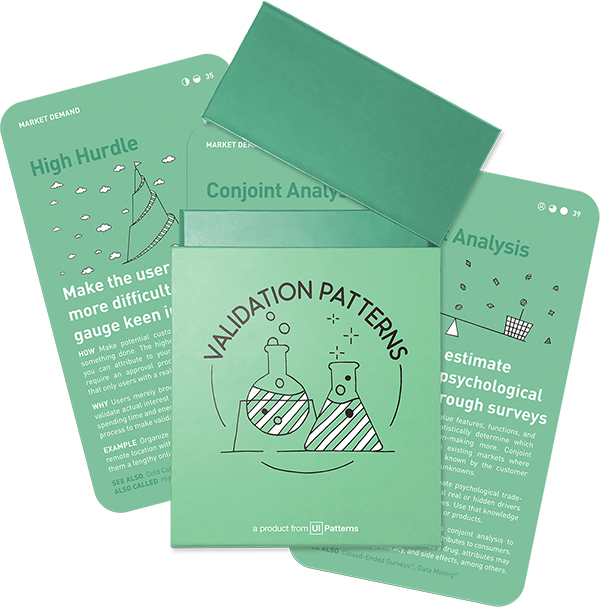
How: Gauge customer interest in a problem by arranging a live event around solving it. It could be a meetup, a conference, a webinar, or similar. If you are ultimately creating a digital product, events can be used to smoke test the content or process that you would like to deliver digitally.
Why: Customers taking time out of their schedule to attend an event is a good proxy indicator for confirming not only that your audience has the expected pain points, but also their willingness to pay for solving a customer problem if you charge for the event. Creating an event for a target market is a product and by organizing one, you will need to figure out how to reach and communicate to your target market as well as what constitutes a useful, pleasant, and inspiring experience for its customers.
Confirm pain points of the customer
By organizing and promoting an event, you are looking to confirm that your audience has the pain points you expect they have (the ones your event promises answer to).
Utilizing events as a method to test market viability offers a unique blend of direct customer engagement and practical market research. By organizing an event, entrepreneurs can validate the existence of a problem among their target audience and test whether they are willing to pay for a solution. This approach is particularly beneficial when the end goal is to launch a digital product, as it allows for an initial evaluation of the content or processes intended for digital delivery. The event serves as a “smoke test”, providing early indicators of market interest and potential.
Setting apart time to join a webinar is investing time in a topic and what you have to say and qualifies as a small hurdle. Attending a physical event signifies a larger hurdle and thus more data reliability. Furthermore, getting users to pay for event access, you are confirming willingness to pay to solve their problem.
Smoke test your content product
If your final intended product is a book, an online course or similarly represent a content product, putting on event to gauge demand is a quick, cheap, and easy way to do so.
Putting up an event increases learning velocity by scaling customer discovery up one step above one-to-one interviews. Further more, delivering content in front of a live audience provide for a great opportunity to probe whether the audience responds with excitement, understanding, and requests for more.
Events that smoke test customer interest and demand can take many forms:
- Meetup group
- Peer-to-Peer events (unconferences)
- Mini half-day conferences
- Gamestyle show
- A trip together
- Support groups
- Networking and drinks
- Support groups
- Conferences (online and offline)
- Webinars
- Live video streaming (i.e. Facebook & LinkedIn live streaming)
Understanding market interest
The core purpose of hosting an event in this context is to answer critical questions about the market. These include gauging who is genuinely interested in the problem you aim to solve, determining effective ways to reach your target demographic, assessing their willingness to pay for a solution, and understanding their preferences and reasons for interest. An event can thus act as a litmus test, revealing the market’s pulse.
To effectively use events as a validation tool, it’s essential to be clear about the learning objectives from the outset. A well-defined cutoff value helps in determining the event’s success in terms of market validation. However, care must be taken to avoid biases, especially in the sales approach. Overly aggressive sales tactics might skew the results, making it difficult to ascertain whether interest is genuine or a byproduct of persuasive selling.
Benefits from the events experiment
Although events themselves can serve as reliable interest and problem validation, they can also help provide a series of other benefits that will help you build your audience:
- Gathering qualified leads (test your channel)
- Upsell or presell of other products or services
Breaks during your event are great opportunities for you to consolidate what you have learned. Breaks provide excellent unstructured time to interview your target audience.
Popular tools
The tools below will help you with the Event play.
-
Meetup
Build a community group that regularly meets around a recurring topic
-
Eventbrite
Event management platoform that lets you charge for events in minutes.
-
WebinarJam
Online video event platform
-
Livestorm
Webinar platform that connects to a range of external services.
Real life Event examples
Validation Pattern card deck
Before releasing the Validation Pattern card for pre-order, the concept of a playbook full of product experiments was tested as a meetup event. Regular meetups in the group attracted around 50-60 participants so attracting 180 for this particular topic was considered validation of the topic.
To test Twitter’s real-time communication potential, the SXSW conference in 2007 served as a live platform. This event showcased Twitter’s unique appeal, demonstrating its capabilities in a dynamic, public setting, leading to a surge in user engagement and highlighting its utility in sharing instant updates.
Source: The Hatching Twitter book
Jaswant’s Kitchen
A family business that sells Indian seasonings and cooking kits, Jaswant’s Kitchen tested their product by selling early versions at small shows. This direct approach to potential customers helped them understand the market demand and the real need for their products.
A collection of 60 product experiments that will validate your idea in a matter of days, not months. They are regularly used by product builders at companies like Google, Facebook, Dropbox, and Amazon.
Get your deck!Related plays
- Event Smoke Test by Tristan Kromer
- The Real Startup book - Event Smoke test by Tristan Kromer, et. al.
